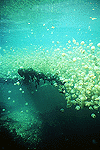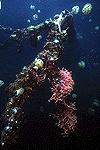 By now many of you have either heard of or have visited Jellyfish Lake in Palau and know of how weird and wonderful it is to swim with the jellyfish. Perhaps you might be interested in hearing about some of the other things that go on in the lake.
By now many of you have either heard of or have visited Jellyfish Lake in Palau and know of how weird and wonderful it is to swim with the jellyfish. Perhaps you might be interested in hearing about some of the other things that go on in the lake.Text and Photos by Kevin Davidson
 By now many of you have either heard of or have visited Jellyfish Lake in Palau and know of how weird and wonderful it is to swim with the jellyfish. Perhaps you might be interested in hearing about some of the other things that go on in the lake.
By now many of you have either heard of or have visited Jellyfish Lake in Palau and know of how weird and wonderful it is to swim with the jellyfish. Perhaps you might be interested in hearing about some of the other things that go on in the lake.
 As the sun moves across the lake, the jellyfish follow to stay in the brightest sunny area. The sun supplies a food source for the algae which grows within the skin of the jellyfish. The algae is the food source for the jellyfish, in essence making them farmers.
As the sun moves across the lake, the jellyfish follow to stay in the brightest sunny area. The sun supplies a food source for the algae which grows within the skin of the jellyfish. The algae is the food source for the jellyfish, in essence making them farmers.
Two types of jellyfish can be found here. The more abundant of the two is mastiga, the golden colored jelly. The clear, round type is the moon jellyfish or aurilia which are found in lower numbers. Whereas the mastiga grows an algae within, the moon jelly is a predator and feeds on a microscopic crustacean called copepods which are plentiful in all ocean waters. The jellyfish became trapped in the lake many thousands of years ago. They have no real predators so over the years have lost their stinging cells or nematocysts.
 Even though the life of these jellyfish may seem carefree, there are a couple of problems in the lake for them. A small, clear anemone, about the size of a golf ball adorns the shallow edges of the lake. When the jelly fish drift too far to the sides of the lake they become entangled in the arms of the anemone. The anemone pulls the doomed jellyfish towards it's mouth and start the digestion process. This may be natures way of having a balance for all, something we as humans have yet to figure out.
Even though the life of these jellyfish may seem carefree, there are a couple of problems in the lake for them. A small, clear anemone, about the size of a golf ball adorns the shallow edges of the lake. When the jelly fish drift too far to the sides of the lake they become entangled in the arms of the anemone. The anemone pulls the doomed jellyfish towards it's mouth and start the digestion process. This may be natures way of having a balance for all, something we as humans have yet to figure out.
 Although their are no large fish here, there are a couple of smaller species. A small cardinal fish can be found living near the edge as well as a small Gobi which spends its time sifting the sand for food. Their diet does not really include jellyfish, but if one should wander too close to the edge these fish might be tempted to have a nip of them.
Although their are no large fish here, there are a couple of smaller species. A small cardinal fish can be found living near the edge as well as a small Gobi which spends its time sifting the sand for food. Their diet does not really include jellyfish, but if one should wander too close to the edge these fish might be tempted to have a nip of them.
There is a variety of other invertebrates that dwell here too. Tunicates, small starfish, and snails all can be seen along the edge. There are thousands of small muscle shells which have made their homes here by attaching to the mangrove roots. Next time you're in any enclosed body of water, be it a small lagoon or backwater area, take a look along the shallow edge and enjoy the variety of small marine life. These area are usually home to many juvenile species of marine life.
Web Site Design | Photography | Destination Info | About Us | News & Events | Site Map | Search | Home | Copyright